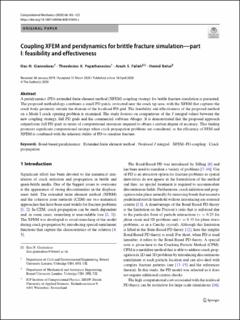Bitte benutzen Sie diese Kennung, um auf die Ressource zu verweisen:
https://doi.org/10.21256/zhaw-20266| Publikationstyp: | Beitrag in wissenschaftlicher Zeitschrift |
| Art der Begutachtung: | Peer review (Publikation) |
| Titel: | Coupling XFEM and peridynamics for brittle fracture simulation—part I : feasibility and effectiveness |
| Autor/-in: | Giannakeas, Ilias N. Papathanasiou, Theodosios K. Soleiman Fallah, Arash Bahai, Hamid |
| et. al: | No |
| DOI: | 10.1007/s00466-020-01843-z 10.21256/zhaw-20266 |
| Erschienen in: | Computational Mechanics |
| Band(Heft): | 66 |
| Seite(n): | 103 |
| Seiten bis: | 122 |
| Erscheinungsdatum: | 18-Apr-2020 |
| Verlag / Hrsg. Institution: | Springer |
| ISSN: | 1432-0924 0178-7675 |
| Sprache: | Englisch |
| Schlagwörter: | XFEM peridynamics coupling; Bond-based peridynamics; Extended finite element method; Nonlocal J integral; Crack propagation |
| Fachgebiet (DDC): | 530: Physik |
| Zusammenfassung: | A peridynamics (PD)–extended finite element method (XFEM) coupling strategy for brittle fracture simulation is presented. The proposed methodology combines a small PD patch, restricted near the crack tip area, with the XFEM that captures the crack body geometry outside the domain of the localised PD grid. The feasibility and effectiveness of the proposed method on a Mode I crack opening problem is examined. The study focuses on comparisons of the J integral values between the new coupling strategy, full PD grids and the commercial software Abaqus. It is demonstrated that the proposed approach outperforms full PD grids in terms of computational resources required to obtain a certain degree of accuracy. This finding promises significant computational savings when crack propagation problems are considered, as the efficiency of FEM and XFEM is combined with the inherent ability of PD to simulate fracture. |
| URI: | https://digitalcollection.zhaw.ch/handle/11475/20266 |
| Volltext Version: | Publizierte Version |
| Lizenz (gemäss Verlagsvertrag): | CC BY 4.0: Namensnennung 4.0 International |
| Departement: | School of Engineering |
| Organisationseinheit: | Institute of Computational Physics (ICP) |
| Enthalten in den Sammlungen: | Publikationen School of Engineering |
Dateien zu dieser Ressource:
| Datei | Beschreibung | Größe | Format | |
|---|---|---|---|---|
| 2020_Giannakeas-etal_Coupling-XFEM-and-peridynamics-I.pdf | 2.88 MB | Adobe PDF |  Öffnen/Anzeigen |
Zur Langanzeige
Giannakeas, I. N., Papathanasiou, T. K., Soleiman Fallah, A., & Bahai, H. (2020). Coupling XFEM and peridynamics for brittle fracture simulation—part I : feasibility and effectiveness. Computational Mechanics, 66, 103–122. https://doi.org/10.1007/s00466-020-01843-z
Giannakeas, I.N. et al. (2020) ‘Coupling XFEM and peridynamics for brittle fracture simulation—part I : feasibility and effectiveness’, Computational Mechanics, 66, pp. 103–122. Available at: https://doi.org/10.1007/s00466-020-01843-z.
I. N. Giannakeas, T. K. Papathanasiou, A. Soleiman Fallah, and H. Bahai, “Coupling XFEM and peridynamics for brittle fracture simulation—part I : feasibility and effectiveness,” Computational Mechanics, vol. 66, pp. 103–122, Apr. 2020, doi: 10.1007/s00466-020-01843-z.
GIANNAKEAS, Ilias N., Theodosios K. PAPATHANASIOU, Arash SOLEIMAN FALLAH und Hamid BAHAI, 2020. Coupling XFEM and peridynamics for brittle fracture simulation—part I : feasibility and effectiveness. Computational Mechanics. 18 April 2020. Bd. 66, S. 103–122. DOI 10.1007/s00466-020-01843-z
Giannakeas, Ilias N., Theodosios K. Papathanasiou, Arash Soleiman Fallah, and Hamid Bahai. 2020. “Coupling XFEM and Peridynamics for Brittle Fracture Simulation—Part I : Feasibility and Effectiveness.” Computational Mechanics 66 (April): 103–22. https://doi.org/10.1007/s00466-020-01843-z.
Giannakeas, Ilias N., et al. “Coupling XFEM and Peridynamics for Brittle Fracture Simulation—Part I : Feasibility and Effectiveness.” Computational Mechanics, vol. 66, Apr. 2020, pp. 103–22, https://doi.org/10.1007/s00466-020-01843-z.
Alle Ressourcen in diesem Repository sind urheberrechtlich geschützt, soweit nicht anderweitig angezeigt.